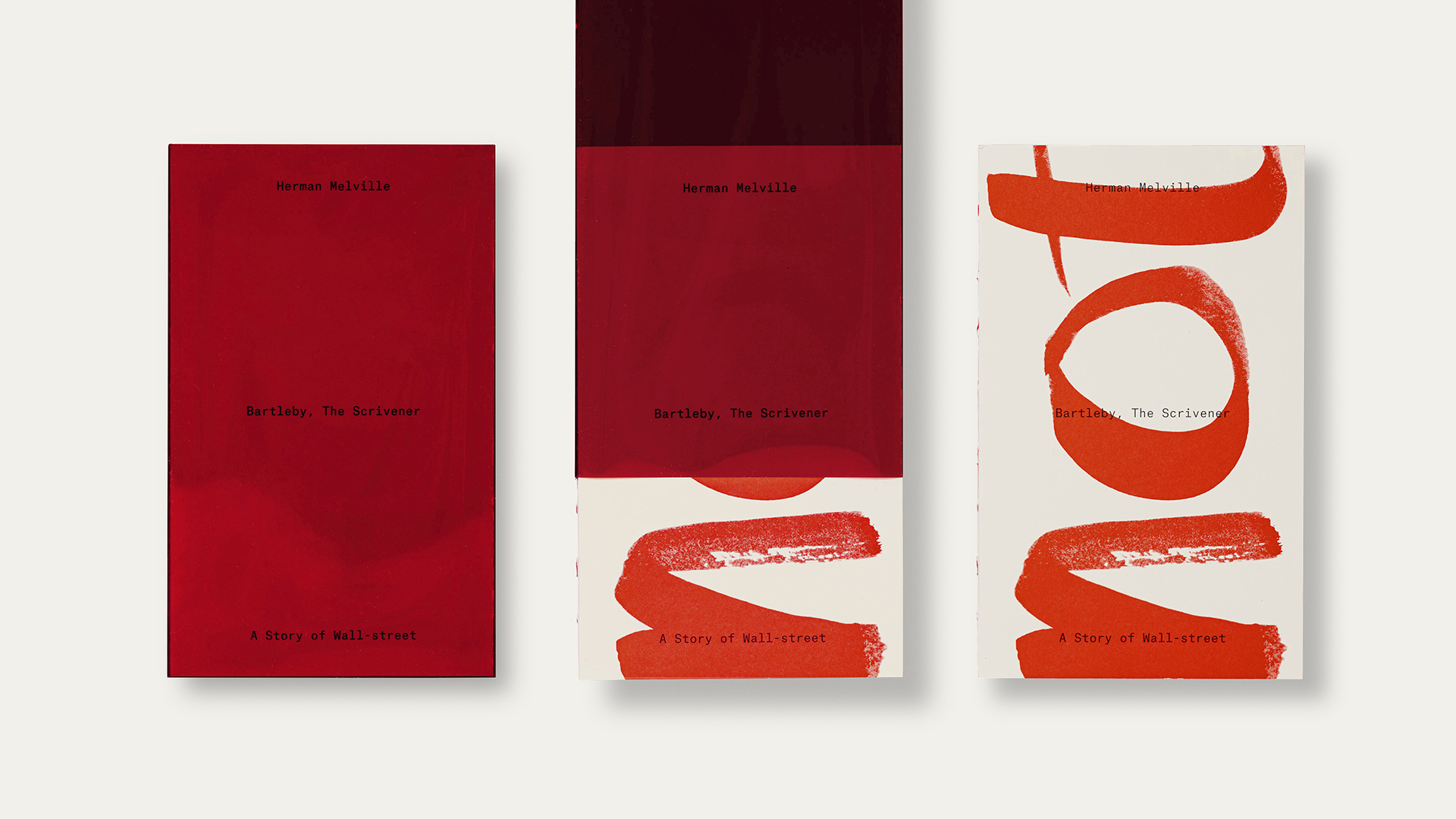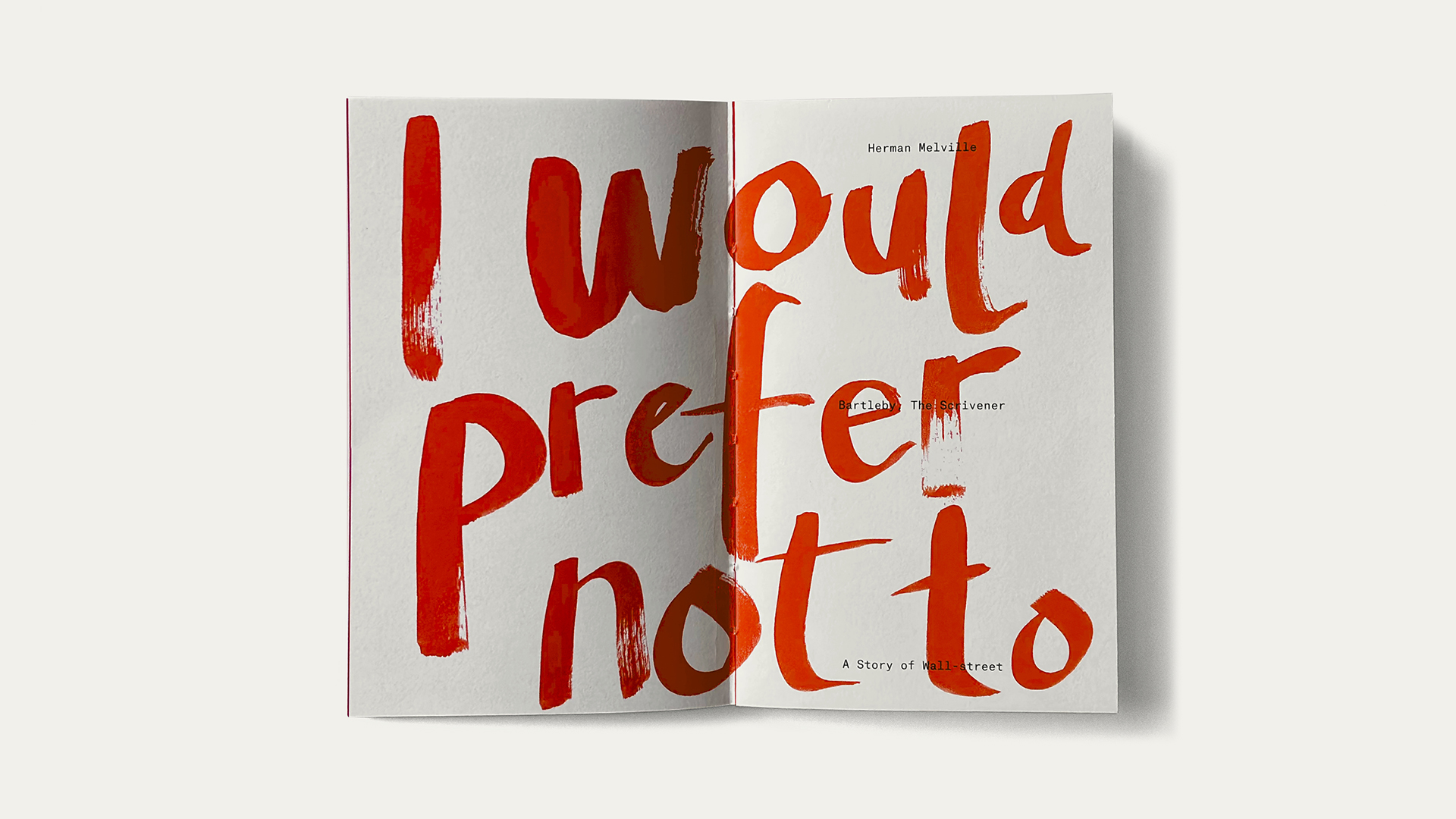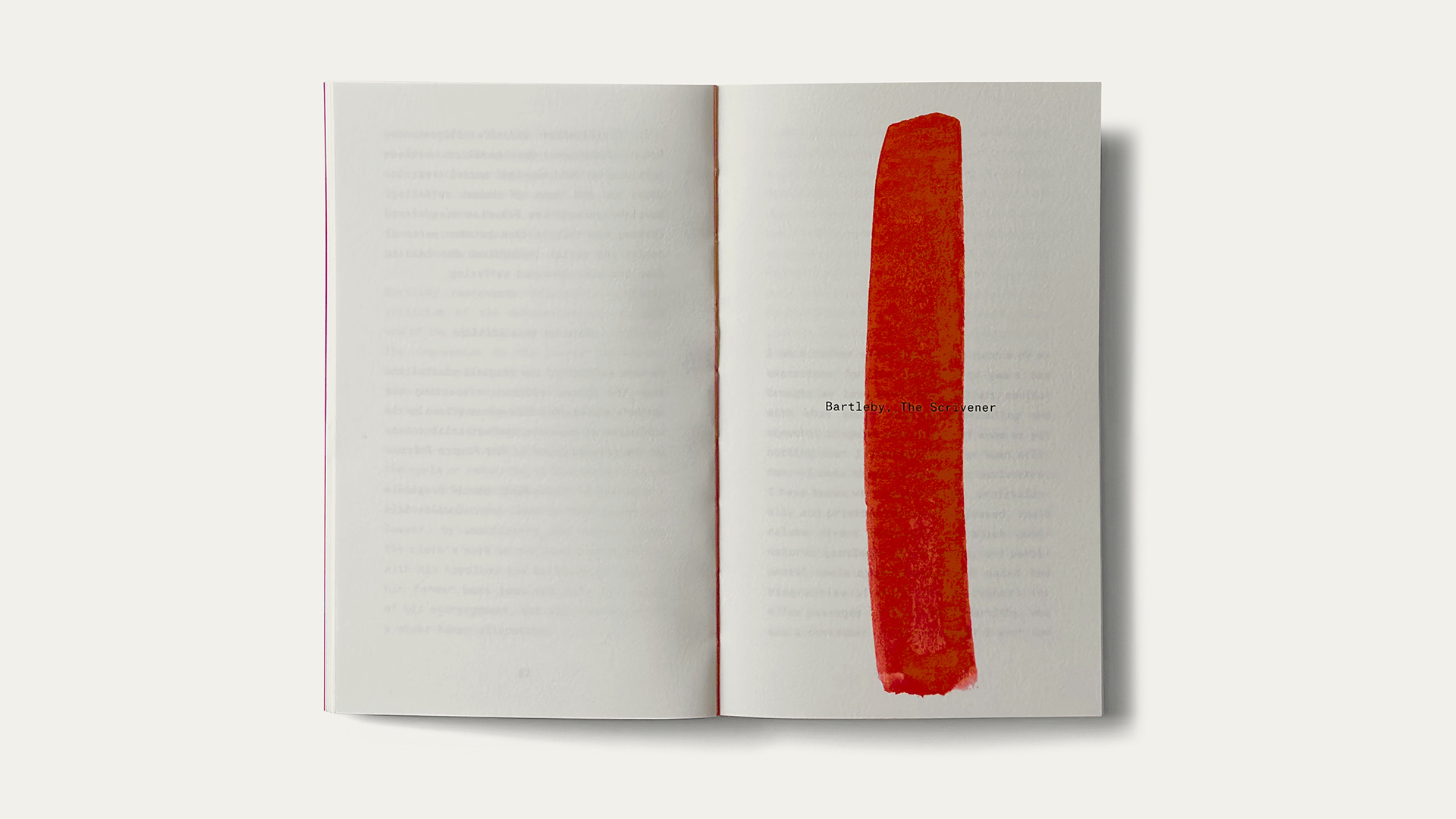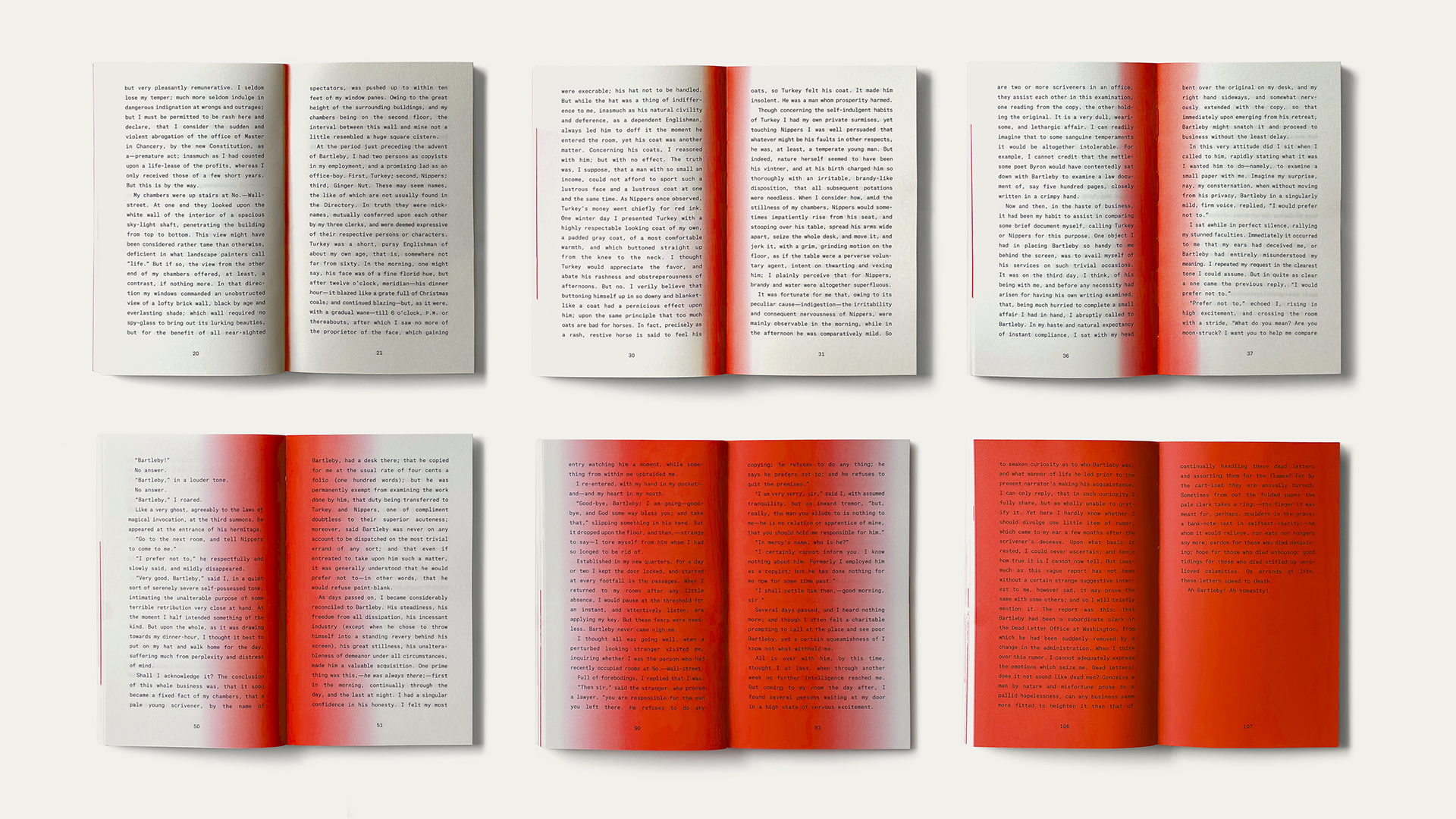







bartleby, the scrivener
“The quiet refusal that challenged the rules of modern literature”
by Herman Melville
The boat trip that changed the course of children's stories.
Bartleby, the Scrivener subtly transformed storytelling with its enigmatic narrative and haunting simplicity, questioning conformity and the nature of human connection. Melville’s enigmatic tale, centred around a character who simply “would prefer not to,” continues to intrigue and unsettle readers, standing as one of the most quietly provocative and enduring works in American literature.
collector's edition
This limited edition of 500 hand-numbered copies is a meticulously crafted hardcover, bound in red board with exposed spine and hand-sewn sections. Printed on 100gsm Munken Pure Rough paper, the book is wrapped in an acetate jacket that not only protects the volume but also serves as a red filter — revealing an alternate cover when removed. The title typography was specially developed from a hand-painted original created exclusively for this edition. Each copy is individually enclosed in a flannel pouch, ensuring both protection and a refined presentation.
£137
what is new and special?
Jhambo Ink’s edition of Bartleby, the Scrivener transforms Melville’s haunting story into a bold, immersive experience. Crafted in striking red and white, the pages start clean and gradually tint deeper red until fully saturated, symbolizing Bartleby’s gradual withdrawal into silence, refusal, and ultimately, death.
Across the pages, Bartleby’s famous phrase, “I would prefer not to,” appears repeatedly—not as neat text, but as graffiti-style tags, reminiscent of street art’s raw, defiant expression. These scattered, hand-tagged phrases feel like Bartleby’s quiet rebellion sprayed across the book, marking it with a sense of restless resistance and urban grit.
This edition makes Melville’s story tangible and immediate—inviting readers to feel the weight of Bartleby’s refusal not just through words, but through striking visuals and design. Jhambo Ink’s Bartleby is a powerful fusion of literature and art, where silence speaks loudly and rebellion is written on every page.


learn more
Herman Melville, one of America’s most complex literary voices, wrote Bartleby, the Scrivener in the early 1850s, during a period of personal frustration and fading commercial success after Moby-Dick. Inspired by the impersonal world of Wall Street and perhaps his own feelings of isolation, Melville crafted the story of a quiet, passive clerk whose simple refusal—“I would prefer not to”—became a haunting symbol of silent resistance. What began as a short tale soon evolved into a subtle yet profound critique of modern work, social alienation, and human disconnection. Over time, Bartleby has transcended its modest origins, becoming one of Melville’s most enigmatic and enduring works.
how to
handle
your book
This limited edition of 500 hand-numbered copies is a meticulously designed hardcover, bound in red board with an exposed spine and hand-sewn sections.
Printed on 100gsm Munken Pure Rough paper, it is wrapped in an acetate jacket that both protects the book and acts as a red filter—revealing an alternate cover design when removed.
The title typography was specially developed from an original hand-painted artwork created exclusively for this edition by INDEX.
Each copy is enclosed in its own flannel pouch, offering both protection and a touch of refinement.
In 1853, Herman Melville, an American novelist best known for Moby-Dick, published Bartleby, the Scrivener: A Story of Wall Street, a work that would become one of the most enigmatic and quietly influential pieces of 19th-century American literature. Set in the impersonal world of Wall Street’s law offices, the story follows Bartleby, a copyist who gradually withdraws from the demands of work and life itself with his simple, unsettling refrain: “I would prefer not to.”
Initially received with confusion rather than praise, Bartleby was ahead of its time—a minimalist narrative that posed deep philosophical questions about labor, individuality, and human connection in an increasingly mechanized society. Often interpreted as a critique of capitalism, a meditation on passive resistance, or a portrait of profound existential despair, the story resists easy categorization.
While lacking the grand scope of Melville’s earlier novels, Bartleby became a touchstone for modernist and postmodernist thinkers, influencing writers like Kafka and Camus. Its stark style and unsettling ambiguity contributed to shifting the American short story towards introspection and psychological complexity.
Unlike Moby-Dick, which struggled commercially in Melville's lifetime, Bartleby slowly gained recognition for its haunting simplicity and thematic depth. Today, it stands as one of Melville’s most studied works, its quiet rebellion continuing to echo in literature, film, philosophy, and discussions around work culture and mental health.
Herman Melville’s Bartleby, the Scrivener sits at the crossroads between existential literature and dark realism, making it difficult to place within a single genre. On the surface, the story follows the routines of a Wall Street office, yet beneath this realism lies a profound meditation on isolation, passivity, and the search for meaning in a world that offers none.
As dark realism, Bartleby portrays the bleak, mechanical nature of modern work and human relationships. Melville’s minimalist setting—a bare office, repetitive copying work, and silent walls—mirrors the psychological emptiness experienced by both Bartleby and his employer. The narrator’s quiet despair and helplessness reflect a deeper psychological realism, examining how individuals respond to someone who simply refuses to participate in life.At the same time, Bartleby anticipates existential literature, decades before the term existed. Bartleby’s repeated phrase, “I would prefer not to,” becomes a symbol of passive resistance against the absurdity of life itself. Like Kafka’s characters or Camus’ anti-heroes, Bartleby embodies existential withdrawal: a quiet rejection of the rules and structures that society expects everyone to followUltimately, Bartleby blends psychological realism with existential themes, offering a story that is both starkly real and hauntingly philosophical—a narrative where silence and refusal speak louder than action.
Some might argue that the story leans more toward allegory, with Bartleby as a symbol of passive resistance or a critique of capitalist dehumanization, or even Gothic literature, with its haunting, unresolved dread. But these readings don’t negate the existential and dark realism duality; they enrich it.
Melville's early life was marked by hardship after his father’s death, leading him to work various jobs, including time spent as a sailor on whaling ships—experiences that deeply influenced his later writing. His adventures at sea provided the raw material for his early popular novels such as Typee (1846) and Omoo (1847), travel narratives combining exotic landscapes with critiques of colonialism and civilization.
In 1851, Melville published his most famous work, Moby-Dick, a complex and symbolic novel that layers adventure, philosophy, and dark psychological themes. Initially misunderstood by readers and critics, Moby-Dick is now hailed as a masterpiece of American literature, renowned for its exploration of obsession, humanity, and the unknowable forces of nature.
Melville’s literary range extended beyond sea narratives. In Bartleby, the Scrivener (1853), he shifted to the urban world of Wall Street, crafting a minimalist and enigmatic story that would later be recognized as an early exploration of existentialism and passive resistance. His other works, such as Benito Cereno and Billy Budd, continued to explore themes of moral ambiguity, injustice, and the limits of human understanding.
Later in life, Melville turned increasingly to poetry, publishing works like Battle-Pieces and Aspects of the War (1866), reflecting on the American Civil War. His final years were spent in relative obscurity, working as a customs inspector in New York.
Herman Melville passed away on September 28, 1891, largely forgotten by the literary world. However, the 20th century saw a dramatic revival of interest in his work, known as the “Melville Revival,” cementing his place as a central figure in American literary history. Today, Melville’s legacy endures not only through Moby-Dick, but also through his haunting shorter works like Bartleby, the Scrivener, which continue to engage readers with their stark beauty and philosophical resonance.
Jhambo Ink is a creative publishing house dedicated to combining classic literature with bold experimentation. Founded with a passion for storytelling and craftsmanship, Jhambo Ink works at the intersection between art, narrative, and design, offering readers books that are as tactile and visually striking as they are intellectually engaging. At Jhambo Ink, experimentation is at the heart of every project. Whether through innovative formats, unexpected materials, or immersive narratives, each edition aims to challenge traditional ideas of what a book can be. Every book is crafted with care, reflecting a belief that literature can be both collectible and accessible—objects of beauty as well as portals to thought-provoking worlds, experienced via art and word. Driven by curiosity and a spirit of invention, JhamboInk continues to push boundaries, turning books into experiences that stay with readers long after the final page.
Index is a design studio shared by creative partners Ana Santiago (São Paulo, BR) and Asad Pervaiz (NYC, US).
Commissioned by Jhambo Ink to design our publications, their innate love of books is complemented by more than 20 years of experience designing for publishers such as Rizzoli, August Editions, Carambaia, Fósforo, Ikrek Edições, Editora Olhares and Todavia.
Their designs reside in the archives of both the Museum of Modern Art (MoMA - New York) and The British Library (London) and have received awards from Art Directors Club, Graphis and the American Institute of Graphic Arts.
